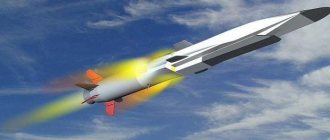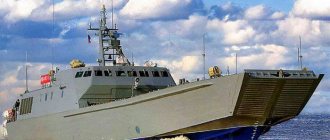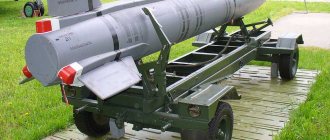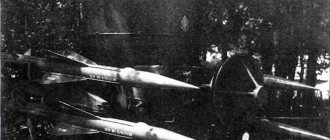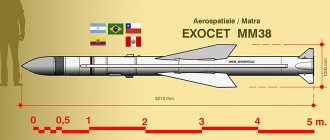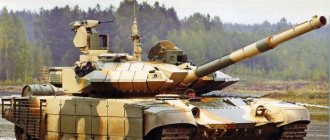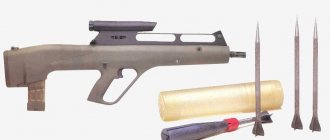The newest Russian air-to-air missile with a range of 200 km has passed state tests
A long-range air-to-air guided missile with a multifunctional radar and inertial control system is designed to destroy air targets (fighters, bombers, military aviation aircraft, helicopters, cruise missiles) at any time of the day, at all angles, in electronic warfare conditions, on against the background of the earth and water surfaces, including with multi-channel shelling.
The missile is part of the missile armament of MiG and Su type aircraft.
“In 2022, state joint tests of the long-range export missile RVV-BD were carried out, the design documentation for the product was assigned the serial letter “O1,” reports the corporate newspaper “Vympel” of JSC “GosMKB “Vympel” named after. I. I. Toropova.”
According to the publication, “the documentation for the RVV-BD product was transferred to KTRV JSC to ensure serial production and delivery of products.”
The tactical and technical characteristics of the RVV-BD are as follows: flight altitude of the targets hit - from 0.015 to 25 km; flight speed of targets hit - up to 2500 km/h; maximum launch range in the front hemisphere - up to 200 km; minimum launch range in the rear hemisphere - 1 km; overload of targets hit - up to 8 g; rocket length - 4060 mm; caliber - 380 mm; starting weight - no more than 510 kg; target acquisition range for tracking by the homing head (in the front hemisphere) - 30 km; type of warhead - high-explosive fragmentation; warhead weight - 60 kg.
The RVV-BD guidance system is inertial with radio correction and active radar homing at the final section of the trajectory.
The rocket is made according to a normal aerodynamic design with a low aspect ratio wing with a large chord. The stabilizers are in the folded position before starting. The product is equipped with a dual-mode launch and propulsion solid propellant rocket engine (SDTT).
The RVV-BD missile is equipped with an improved active radar homing head (GOS) 9B-1103M-350/OKR “Shaiba” developed by the Agat Research Institute. Target designation before launch is carried out in a sector of 120 degrees in the forward hemisphere of the carrier aircraft. The seeker has a new miniature digital signal processor with a large memory capacity and increased speed. Instead of conventional mechanical gyroscopes, the seeker uses fiber-optic gyroscopes and mechanical gyroscopes with forced entry into operating mode, thereby reducing the time it takes to prepare the rocket for launch.
The improved seeker has a high degree of unification and can be used in any missiles - both anti-aircraft and air-to-air missiles within the caliber of 200-400 mm.
K-37/R-37/RVV-BD (in the West the missile was designated AA-13 Arrow) was developed by the Vympel State Design Bureau as a further development of the R-33 air-to-air missile to arm the MiG-31M interceptor. The development of the rocket began according to the Decree of the USSR Council of Ministers of April 8, 1983. The preliminary design of the rocket was defended in 1983. Testing began in 1988 with autonomous ballistic missile launches without a control system. In 1989, flight tests of the R-37 missiles began.
In March 1992, the rocket was first presented to the public as part of the Minsk show of new aircraft. The products were demonstrated on the ventral suspension of MiG-31M interceptors. In April 1994, Russian President Boris Yeltsin congratulated the creators of the missile for defeating an air target at a record range of 304 km.
During the development process, the missile was renamed RVV-BD. Visually, the early R-37 differs from the RVV-BD in its head compartment shortened by 14 cm, a modified shape of the head compartment with a radio-transparent fairing, and folding upper rudders-stabilizers.
Testing of the rocket continued until 1997.
After 1997, due to a breakdown in cooperation with Ukrainian enterprises that were involved in the creation of missile guidance systems, a decision was made to develop a guidance system using only Russian components.
By 2007, the Tactical Missiles Corporation was already working on the creation of the RVV-BD missile, which was almost a complete analogue of the R-37 missile.
In 2011, it was decided to begin mass production of the rocket. In 2014, the RVV-BD missile was adopted by the Russian Air Force and its serial production was officially launched. MiG-31BM fighter-interceptors are equipped with R-37 missiles. In 2022, a modification of the R-37M missile was integrated into the armament complex of the fifth-generation fighter Su-57, and test launches of the missile from the Su-35S were also carried out.
The export version of the RVV-BD was first shown at the MAKS-2011 air show.
The intended service life of the product is 8 years. The assigned resource for an unlimited number of take-offs and landings from a concrete-covered runway (20 take-offs and landings from ground and metal runways) is 50 flight hours. The time of continuous operation of the equipment in flight under the carrier aircraft is 3 hours. The serviceability of the missile's onboard equipment during operation is checked annually at the Oka-E aircraft weapons preparation complex or at the Oka-620 control equipment.
“The RVV-BD product in its export version in no way falls under the articles of the Missile Technology Control Regime (MTCR). Let us recall that the key limit for missile systems (as well as other unmanned vehicles) to fall within the scope of the MTCR is formulated as the ability to deliver a payload weighing at least 500 kg to a range of at least 300 km. Thus, there are no obstacles to the export of RVV-BD in this regard. Just as there is no need for any restrictions on the tactical and technical characteristics of this product,” Konstantin Makienko, deputy director of the Center for Analysis of Strategies and Technologies, explained to Gazeta.Ru.
According to the specialist, countries whose air forces are equipped with Su and MiG aircraft should be primarily interested in purchasing RVV-BD. For example, India, China, Armenia and Belarus.
Background
Fighter aircraft began to be armed with aircraft missiles back in the 1930s. The first Soviet aircraft to receive missiles in addition to machine guns was the I-16 fighter model. Rockets were then unguided, so the pilot could influence the trajectory of the projectile only before it was launched. The pilot had to carefully meet the launch conditions in terms of accuracy and range. It was quite difficult to do this during an air battle. The accuracy of such fire is inferior to that of onboard machine guns and cannons. The only advantage of the rockets was their solid caliber and the fact that one hit was enough to destroy an enemy aircraft.
The first tests of guided missiles took place in Germany during World War II. It is worth noting that in those years, rifled aircraft weapons (cannons and machine guns) reached their perfection. Proof of this is the success of fighter pilots in various battles. At that time, aviation weapons were ideally suited to existing aircraft, and in the hands of a skilled pilot they made it possible to achieve success in a maneuverable air battle. But when supersonic jet aircraft appeared, the speed of aircraft increased, and with it the spatial scope of air combat increased, the need arose for missile weapons of a new level. In addition, it was necessary before to solve combat missions at night and in difficult weather conditions.
In the post-war period, the first guided air-to-air missiles appeared in America. The United States became an innovator in this field, but the creation of guided missiles was facilitated by specialists from Germany, who were taken to America after the defeat. A little later, the USSR also achieved success in the development of guided missiles.
RVV-AE
In the mid-2000s, a model of an air-to-air missile (Russia) appeared, combining all the characteristics described above. Currently, it continues to improve. The export version of the new generation air-to-air missile has been demonstrated to the public more than once at aviation shows and international arms exhibitions under the name RVV-AE. In 2003, a modified version called RVV-SD appeared. Many people are interested in what is the speed of the RVV-SD air-to-air missile? So, this rocket is capable of reaching speeds of up to 4500 km/h.
The new missile received a dual-band radio correction line with increased speed, as well as a high-precision control system. A new two-pulse solid propellant motor with a controlled pause and increased fuel mass can operate for up to 100 seconds, thereby providing increased power to the rocket. Thanks to adaptive combat equipment with the ability to control the killing field, the missile can effectively hit the target even with an increased possibility of missing.
Difficulties
At the same time, there are factors that prevent the rapid solution of these problems. We are talking mainly about the need to minimize the mass, dimensions and cost of missiles.
The requirements for missiles from pilots are not limited to the “fire and forget” principle. Pilots would like the rocket's requirements for launch conditions to be minimized. The helmet-mounted target designation system effectively copes with the task in close air combat, but is completely unsuitable for long-range missile combat, which is becoming an increasingly promising direction for the development of aerospace defense aviation.
Crews need smart rockets, but high-tech rockets also need skilled technicians. There is an opinion that the sixth generation of fighters may become unmanned. This prospect is quite real, given the rapid development of the concept of “non-contact wars”. Be that as it may, the gradual and - most importantly - constant increase in the tactical and combat characteristics of air-to-air missiles leads to them gaining a qualitatively new place in the armed conflict and increasing the role of fighter aircraft in the aerospace defense as a whole.
Increased demands
By the end of the 90s, it became obvious that in the future semi-active radar heads would no longer satisfy all the requirements for missile control systems. An active radar head of a more complex design was needed.
The development of new missiles was complicated by the use of processors for fast digital signal processing with high noise immunity. For the pilot, such a rocket was the ultimate dream, because it embodied the “set it and forget it” principle.
Today in Russia, work continues on the creation of a new generation of missiles and radar homing heads that incorporate a digital signal processing system in a wide frequency range and have a minimum length of the analog part of the path, as well as multifunctional high-performance processors. Radar heads with such parameters will be able to detect and track a target in range and speed, carry out parallel analysis, operate in the “without target designation by speed” mode, and also implement noise immunity algorithms.
Homing missiles
In 1962, the first R-3S homing missiles entered mass production. The homing heads responded to a source of thermal radiation, which, as a rule, was the jet nozzle of the engine of an enemy aircraft. The system was suitable for maneuverable air combat, but in the event of a sharp maneuver of the target towards the missile, the attack was disrupted or ended in a miss. In an average air battle, out of ten missile launches, no more than two reached their targets. Homing missiles could only attack the rear hemisphere of an enemy aircraft and only in normal weather conditions. A zero-angle launch could lead to premature activation of the remote fuse. The reason for this is that the rocket hit the stream of hot gases from the jet engine of an enemy aircraft.
The first guided missiles had equipment for guidance and homing that was equipped with analog information processing tools and had a strict operating logic. When the thermal homing head steadily captured the target, the pilot could understand this by the characteristic sound coming from the headphones of his headset. As the aiming error decreased, the sound intensified.

